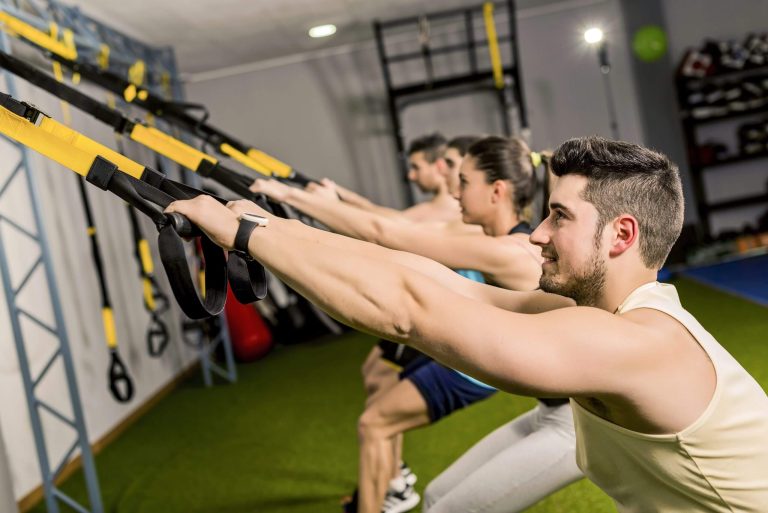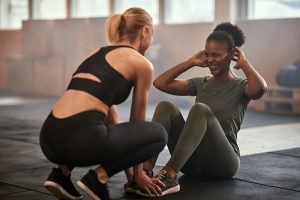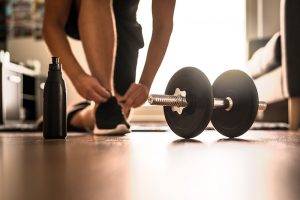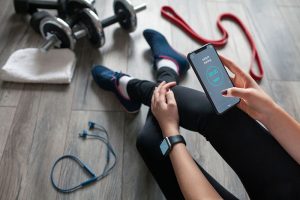There are plenty of things we can’t control during a pandemic. One of the things we can control is how we move our bodies. Gyms have reopened throughout Oregon and are adhering to CDC guidelines in order to ensure the health and safety of both staff and clients. But getting started is often the most difficult part of a personal fitness program. Once a routine is established, it becomes an ingrained part of your lifestyle. Before you can start your journey there are several steps we need to take to give you the best chance for success. As Newton’s First Law of Motion states, an object in motion stays in motion, while an object at rest states at rest. Here are nine secret ways to get in motion and remain there. Are you ready?
1 – What do you want to accomplish and why?
Any physical activity is better than none at all. But like most things, it’s helpful to identify what your objectives are before beginning a workout regimen.
Are you looking to lose weight?
Do you want to look good naked?
Is it important to you to lose fat?
Do you want to have more energy to keep up with your kids?
Run a half-marathon?
Do you desire a change in your general body shape?
Do you want to build lean muscle?
How about improving your cardiovascular endurance, so that you have a stronger respiratory system to fight anything that comes your way? (COVID)
Once you’ve established your intention, your workouts can be tailored around this.
Gym workouts will target one or more of three key areas:
Aerobic endurance and capacity: Otherwise known as good old-fashioned stamina, this is your ability to keep exercising at a moderate intensity for long periods of time. Examples of this include jogging for three miles or playing a basketball game.
Mobility, flexibility, and stability: Good mobility is being able to take your muscles and joints through their full range of motion while being active. Flexibility is when muscles and joints are put through active and passive ranges of motion. Stability is being able to maintain control of the movement and position of your joints during physical activity, which directly correlates to your balance and coordination.
Strength and core strength: This is when your muscles produce force against some form of resistance. The resistance can be an external object (weights during bench press) or your own body weight (sit-ups) or a bodyweight squat.
However, if your goal is to build strength, that doesn’t mean ignoring the other two areas. Although strength exercise would be your focus in this case, improving your aerobic capacity or mobility will only benefit you.
2 -Set daily and weekly goals
If you follow us in IG or Facebook you’ve seen my content about your goals. If you engage with us then you know I reply to every message.
The goal itself has to be clear and defined.
What is it that you want?
Be very deliberate about what you’re looking for and make sure you put a plan to go in and execute
I really like to think I’m pretty smart, but it’s not just me. Numerous academic studies have demonstrated that goal setting is directly correlated to higher levels of achievement. A 2015 study from Gail Matthews, Psychology Professor at Dominican University of California, found that 76 percent of participants achieved their goals when they wrote them down and provided weekly progress to a friend, compared to 43 percent of participants who simply were asked to think about a goal and did not follow a process to write them down and formulate an action plan.
But our goals are often so lofty that it’s easy to talk ourselves out of them. If your objective is to lose 25 pounds and you only lose one in the first week, the thoughts that race through your head can lead to feeling overwhelmed. I have 24 more pounds to go? Another 24 more weeks of dieting? Maybe my body isn’t meant to do this. This is the point where many people quit.
Instead of thinking about how far away you are from the top of the mountain, focus on the incremental steps needed to get there. Not only will setting shorter goals keep you from thinking too far ahead, but it will also keep you on track and more aware of your progress.
What are you doing today for your training?
What does your workout scheme look like?
What and how are you training today?
Why are you doing that specific training modality?
Is it to lose body fat ?
Trying to gain lean mass?
Are the actions you’re taking aligning with your goals?
When setting goals, look to use the SMART method to help guide your plans.
S (Specific) – They target a specific area of functioning and focus on building it.
M (Measurable)-The results can be gauged quantitatively, which helps in monitoring progress once the plans have been executed.
A (Attainable/Achievable) – The goals are targeted to appropriate people, yet also customized for individual needs. It acknowledges that no single rule suits all and is flexible in that respect.
R (Realistic) – They are planned and practical in a way that is easily implemented in real life. The purpose of a smart goal is not just providing the plan, but also helping the person execute it.
T (Time-bound) – Incorporating an element of time into the goal makes it more focused.
3 – Make a plan
People who are more planful, or who more carefully think about their fitness goals, have greater rates of success in achieving them. A study from the University of Oregon, published last September in Psychological Science, found that participants who wrote out strict exercise plans went to the gym more frequently than those who did not.
But planfulness isn’t just dutifully writing out your workouts: It’s a mindset. The researchers noted that planful people thought about their goals in four key ways:
- They prioritize future rewards over present ones, especially when the two conflict. This could mean cooking a healthy dinner instead of ordering takeout.
- They recognize that they can recover from setbacks and do not become demotivated when they occur. In other words, a cheat meal doesn’t become a cheat week.
- They pay attention to which tricks and tips work best for their goal planning and identify those that aren’t as effective (some people hate using calendars but won’t work out without a buddy).
- They see how today’s actions lead to tomorrow’s successes. You may not feel like running on a certain day, but putting on your sneakers anyway means you’re moving closer to peak fitness for your marathon.
4 – Schedule times for exercise
We’ve all made a plan to exercise on Friday morning and then said, “I’ll do it this afternoon.” The afternoon passes by and you promise to exercise over the weekend.” Before you know it, you’re making deals with yourself and you vow to start your week off right on Monday morning.
Of course, we all know how that ends up!
Here is what I think: Sometimes you may have to make deals with yourself. Trick yourself into doing your work! I don’t care whatever it takes! Remember, IF YOU GOAL is important enough, you’ll find a way.
Putting off exercise becomes far too easy unless you block off a specific time to do it. If possible, it’s easier to get into a routine when you hold a consistent time to exercise throughout the week.
Some people prefer to get their workout done before heading into the office, while others want to let off steam immediately after a tough day.
If work and family life make it tough to hold a consistent routine during the week, commit to exercising on both weekend days and squeeze in the remaining sessions where they fit.
Do me a favor, grab your calendar and add a meeting on your calendar where you want to get your exercise in and..AND title it to mirror your goal.
Example, if you want to exercise in the morning 3x a week and your goal is to lose fat; add a calendar event three times this week that says “lose fat”.
Sounds crazy, right? I’ve seen more people reach success in their fitness journey when they do this.
You also want to plan your workout in advance, right down to the number of exercises and reps. Getting started is often hard enough without having to think about what you’ll do that day. Make the process as easy on yourself as possible.
What’s that saying? “an ounce of preparation is worth a pound of cure”- Benjamin Franklin
5 – Be prepared for resistance – and push through it
Even if you’re able to complete your workout from anywhere, it’s often more beneficial to do it at a gym because it’s easy to get distracted at home. If you’re feeling tired, the comfortable couch in your living room or Netflix in your bedroom will look a lot more appealing than burpees.
In their book Peak Performance, Brad Stulberg and Steve Magness explain how our surroundings impact our behavior. We associate certain physical spaces with specific attitudes and actions. If you associate your bedroom with relaxation, then it won’t be an ideal spot for a tough training session.
But there are times when getting to a gym simply may not be possible.
Effective home workouts require the self-discipline to remove all distractions from your space. Put your phone on airplane mode, turn your laptop off and remove them from the room. Opening a window or rearranging some of the furniture in a room can also create a different environment that’s more conducive to working out.
If all else fails, remember that even small amounts of physical activity are better than none at all. A January 2019 study from the journal Applied Physiology, Nutrition and Metabolism found that even 20-second exercise “snacks” like climbing a couple of flights per stairs yielded small, but measurable improvements in aerobic capacity after several weeks.
We’re certainly not advocating for 20-second workouts, but it’s important to recognize that your workout progress will likely resemble the ideal value-line for stocks if done consistently. Although there may be some slight dips on certain days, this is not a cause for concern as long as your overall progress continues to trend upward.
6 – Keep it simple
COVID-19 has required us to simplify our lives in many ways, but this is a good practice to adhere to if you’re getting back into working out.
Start out by selecting an activity that doesn’t require new skills, such as jogging. This activity should also be something that can be done year-round, regardless of weather conditions, and require minimal equipment.
This approach can also be tailored to any specific exercises you do. If you’re working out at a gym, focus on exercises that use your body weight such as squats, push-ups and sit-ups. We guarantee that you’ll still break a sweat.
7 – Make it social
It’s no surprise that turning exercise into a social activity often makes it more fun and increases the odds of sticking with a program.
A 2007 controlled trial, published in the British Medical Journal, found that early-stage breast cancer patients who underwent supervised group exercise for 12 weeks enjoyed mental and physical benefits that lasted beyond the program. Another research project found in Annals of Behavioral Medicine showed.
But with the current pandemic, a packed spin class may not be a sensible idea even if it’s open for business.
Build your own QuaranTeam. What’s that? Limited people that workout exclusively together.
Consider asking a friend to join you for a bike ride or to play a socially distant sport like tennis. A research project in Annals of Behavioral Medicine showed that cyclists who biked with a partner rode nearly twice as long as those who went solo.
Many people are using Zoom and other forms of video chat to recreate the group classes they cherish and reconnect with old workout buddies. You could also create a group text chat to share fitness ideas and keep each other motivated.
Let’s not forget “that friend” we all have. Come, on….you know who I’m talking about. They post a story 4-6 times a week about working out. How great they feel, how close they are getting to #goals. While it makes you throw up in your mouth a little; it’s also inspiring and motivational.
Use their energy and motivation to help yourself. Become that motivation for others by being social about your fitness. Share your success. #inspiration
When I think of successful people I know…wait, hang on, allow me to define success first.
Anyone who is talking the talk and walking the walk, someone who is at the top of their game or profession.
Although that can be a vast array of different types of successful people. They all have one thing in common, they had a goal and didn’t let anything get in their way.
Now, I don’t know about you, but I was conditioned at an early age if you want to be successful if you want to be a winner you hang out with winners. If you want to be a crackhead, hang out with crackheads…you get my point.
Document your fitness journey and challenge them as well as yourself at the same time. #pushupchallenge, #burpeechallenge, #plankchallenge There is a reason there are 300,000+ posts with those hashtags.
There are plenty of fitness apps that not only track your own data and help discover new ways to work out but also enable you to follow your friends and cheer each other on. We recommend Activity (for Apple Watch), which allows you to create a group with up to 40 friends and complete assigned activity goals. Strava lets you upload photos to your own feed and monitor the progress of your workout buddies.
Need some extra motivation? Bet real money on yourself and your goals with DietBet, RunBet, and StepBet.
8 – Raise Your Expectations
The unprecedented times we’re living in mean that we’re home far more often than usual, grappling with uncertainty and often dealing with a wide range of emotions.
In other words, this is the time to be kind to yourself.
Working out during this time should serve as a boost for your general health and well-being. This may not be the time to shatter your deadlift record and it certainly isn’t the time to beat yourself up if you aren’t. Set achievable goals and focus on the internal, rather than external, benefits of being physically active. You’ll have plenty of time to meet those goals as well, but the road will be much longer if you don’t maintain a consistent exercise program now.
9 – Consult with a trainer
Now that you have a clear goal of what you want, you tried 1 through 8, and you’re just not getting where you want; have you thought about speaking to someone that can help you turn your dream into reality?
IMO this will probably be the toughest step of the 9.
Allow me to suggest a resource like Thumbtack to find the fitness professional that is right for you. Whatever you’re looking for Thumbtack will conveniently have what you’re looking for in one place.
Another great way to find your trainer is ask someone you know who has had fitness goals similar to yours. Use them for a referral source.
You will not achieve anything without effort.
Staying on top of your fitness goals can be challenging under ideal circumstances, but may seem impossible during the uncertain times we’re living in. Pulling information off the internet you think will help, may not.
Working with a trainer to identify your fitness goals and create a custom fitness plan can eliminate frustration, provide accountability, and instill confidence as you move closer to your goals.
Can’t make it to the gym? Our team of licensed and experienced trainers can create customized workouts for you to do at home, interface with you remotely online, and help set up meal plans that guarantee success.
Give us a call or send us an e-mail to learn more about how we can help.
Do you have a question about staying on top of your fitness goals? Let us know in the comments section, shoot me a DM on IG or Facebook, heck you can send a letter and we’ll be sure to respond!







